Short Squeeze: Key Takeaways
- In the past year, phenomenal short squeezes sparked wild trades — see examples and charts!
- Learn about what causes short squeezes…
- How you can prepare and potentially benefit from the next monster squeeze…
Can this program help you go from rookie to pro trader in only 30 days?!
Since the rise of meme stocks in January 2021, the short squeeze has gone from niche trading to a household topic. The parabolic rallies of meme stocks like Gamestop Corp. (NYSE: GME) and AMC Entertainment Holdings Inc. (NYSE: AMC) helped push this pattern to infamy.
So what causes short squeezes, how do they work, and how can traders identify them? Let’s unpack it all.
Table of Contents
- 1 What Is a Short Squeeze?
- 2 What’s a Short Position?
- 3 What Happens to a Stock Price After a Short Squeeze?
- 4 Why Try Short-Squeeze Trading?
- 5 Short Squeeze Examples
- 6 Short Squeeze Strategy: How to Trade a Short Squeeze
- 7 How to Find Short Squeeze Stocks
- 8 Short Squeeze Data
- 9 How to Build a Short Squeeze Watchlist
- 10 Potential Risk/Reward of Trading a Short Squeeze
- 11 Frequently Asked Questions About Short Squeezes
- 12 What Is a Short Squeeze?
- 13 What Causes a Short Squeeze?
- 14 What Is a Short Position?
- 15 How to Find Short Squeeze Stocks
- 16 The Bottom Line on Short Squeezes
What Is a Short Squeeze?

A short squeeze occurs when short sellers trigger a rise in price on a heavily shorted stock.
To close out their positions, short sellers are forced to buy to cover, creating heavy demand. They clamor to get out as quickly as possible. Thus, they ‘squeeze’ each other out of short positions. And as they do so, they spike the stock price higher.
The more shorts who cut losses and buy to cover positions, the bigger the squeeze.
This year we’ve seen a lot of short squeezes around meme stocks. These are some of the hottest stocks on social media, often supported by the subreddit WallStreetBets (WSB).
As the overall stock market has risen in the past few years, it’s been a rough time for many short sellers (especially any who were shorting meme stocks). It’s one reason I no longer short.
Short squeezes can’t happen without short sellers. Let’s break down the shorting strategy…
What’s a Short Position?

Here’s a quick breakdown of shorting common shares:
- First, you borrow shares from your broker. Short sellers often do this before the market opens.
- Next, you sell the stock. The money from the sale goes into your trading account.
- When the stock price (hopefully) drops, you buy back the shares and return them to your broker. This is called covering.
- You keep the difference in price, less borrow fees and commissions.
Make sense?
Even if you don’t like short selling, you should still learn about it. Study any catalyst that can spike a stock.
A trader who takes a short position is forecasting a drop in a stock’s price in a given period. It’s a strategy to profit if the stock price drops. (Learn more about short selling here.)
Oversized short positions are the ultimate target for short-squeeze traders. They look for heavily shorted stocks, then weaponize that short interest into a bullish squeeze.
Just look at meme stocks to understand the power of short squeezes. They also show how risky shorting can be…
The Dangers of Shorting
When you short a stock, you borrow shares of a stock from your broker. Then you buy the stock at a later date for a lower price. It’s a way to sell the stock before you buy it. It can seem backward.
What you must know is that you could lose more money that’s not even yours if you borrowed it using margin.
Going long is typically less risky than short selling … Shorting involves margin and borrowing shares on a stock that soars way past your initial investment.
When you go long, you can only lose the money you put in. Stocks can’t go below $0. But when you short, your losses can be exponential.
Look at this chart for Blackberry Limited (NYSE: BB) for one example. See if you can guess where the short squeezes happened (hint: late January and early June).

Oddly enough, sometimes the worst companies in the world become the best-performing stocks in the world — all because of short squeezes.
What Happens to a Stock Price After a Short Squeeze?
A successful short squeeze sends the underlying stock WAY higher. And the trading volume will also be above the stock’s daily average.
After a huge rally, short squeezes usually end in dramatic blow-off tops. Then the share price usually craters back to earth just as fast as it shot to the moon.
Here’s another example with Nokia Corporation (NASDAQ: NOK)…
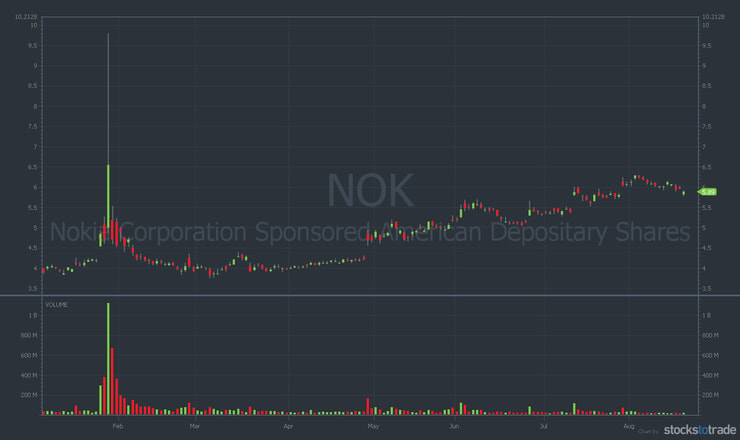
Notice January 27. The stock traded from a low of $4.87 to a high of $9.87 — a swing of 100% in one day.
The price action in a short squeeze can look as if the company just announced the cure for cancer. But really, short squeezes are caused by a pretty basic market mechanic.
It has to do with the specific requirements for opening short positions, and how aggressive long traders weaponize these requirements to their advantage.
Why Try Short-Squeeze Trading?

Short-squeeze trading has led to some crazy gains in recent history, so pay attention.
Let’s say you’re looking at a fundamentally flawed company. It has terrible management, poor sales, no adequate funding…
But it’s arguably one of the best short-squeeze opportunities. And the company makes a sudden announcement. The stock price goes from single digits to $100+/share in just days (or hours).
This happened famously with GameStop. More on that later…
You’re in a position to potentially profit from the short sellers in this situation. They forecasted a drop in the share price because that’s the way the company was heading.
Now, the price is shooting up, and shorts are exiting positions like crazy, buying to cover.
And who gets to profit from those exiting their short positions? It could be you.
Basically, you can bet against the short sellers and win, and it’s not quite as risky as short selling itself. That’s not to say there’s no risk. You have to be careful in these trades. They move fast.
It’s also tough to judge which short squeezes will go supernova…
You can pay attention to social media to look for short squeeze plays. The Reddit rumor mill often starts long before any meaningful move in a stock.
Short Squeeze Examples

Let’s take a look at two of the most famous short squeeze examples of 2021…
#1. GameStop Corp. (NYSE: GME)
No doubt you probably heard about the infamous January short squeeze in GameStop Corp. (NYSE: GME). GME changed the short squeeze game forever…
The initial catalyst was greed from short sellers…
In January 2021, GME’s short interest as a percentage of float reached a whopping 138%. Dozens of hedge funds built up outsized short positions in the name (and hadn’t covered their borrowed shares).
WallStreetBets traders quickly pointed this out, suggesting that it wouldn’t take much for the subreddit to squeeze the stock to new highs.
The elevated short interest had strapped a bomb around GME shares, and Reddit traders were ready to hit the detonator.
It wasn’t long before stock market history was made. For the first time in recent memory, retail traders outsmarted legacy hedge funds. The results were incredible…
Over the following two weeks, GME surged over 2,300% — from under $20 on January 13 to an all-time high of $483 on January 28.
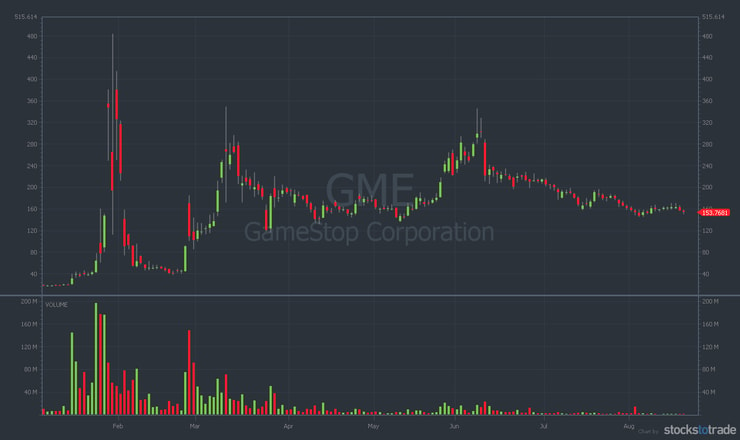
For obvious reasons, the GME rally continues to be one of the best examples of a short squeeze.
And just a few months later, WSB caused ANOTHER insane squeeze in a different heavily-shorted stock…
More Breaking News
- VCIG’s Latest Moves: A Boom or Bubble in the Making?
- From Dreams to Reality: Can Lucid Group Power Through Market Setbacks?
- Growth or Bubble? Decoding the Rapid Rise of INM Stock
#2. AMC Entertainment Holdings Inc. (NYSE: AMC)
In May 2021, the traders on Reddit got another idea — AMC Entertainment Holdings Inc. (NYSE: AMC).
But this time, the primary catalyst was a bag of popcorn. Seriously.
In June, AMC launched an exclusive service for retail traders with a welcome note thanking traders for their support. They included a coupon for a free large popcorn with proof of stock ownership.
At the time AMC’s service went live, AMC stock was trading for around $32. Traders rushed to the bid line, snatching up shares and bullish call options.
They drove the price up as much as 100% on Wednesday, June 2. AMC shares reached an intraday high of $72.62.
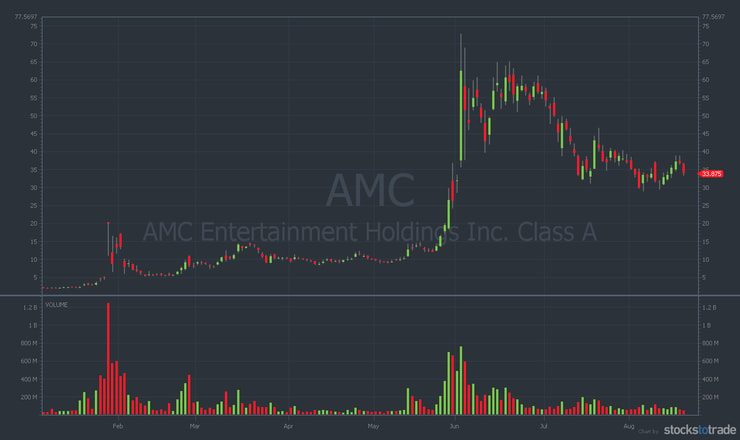
The AMC surge proved that retail traders aren’t going anywhere. And some thought that WSB was a one-hit wonder.
The short squeeze is here to stay. With that in mind, let’s consider how you could trade one…
Short Squeeze Strategy: How to Trade a Short Squeeze

The idea behind a short squeeze is to take a long position on stocks when short sellers are closing out their positions like crazy. Reddit traders are infamous for this.
For example…
In April, WSB traders selected a new target for a short squeeze — long-range lidar manufacturer Microvision Inc. (NASDAQ: MVIS).
The beginning of April was slow for MVIS. From April 1 to April 20, the stock experienced a period of sustained selling. It declined nearly 40% in under three weeks — from $17.07 to a monthly low of $10.08.
As the price continued to drop, the short positions kept piling on…
But on Wednesday, April 21, Reddit traders drew a line in the sand. They started purchasing shares and bullish call options, boosting the stock 21% — from $10.42 to $12.49.
Over the following three days, retail traders engineered an eye-popping short squeeze.
At its peak, MVIS was up over 170% in five days — reaching an all-time high of $28 on April 27.
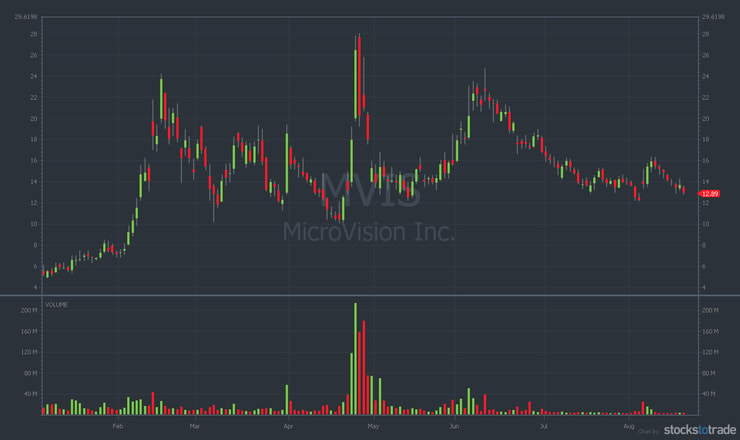
How to Find Short Squeeze Stocks
Finding short-squeeze stocks is no easy task. If it was, everyone would do it.
That being said, the notoriety of meme stocks has led to more online resources for evaluating short interest. If you search “short squeeze” on WallStreetBets, you’ll get thousands of hits.
The major problem with short-squeeze stocks is the added risk. You’re facing extreme volatility as well as information that might or might not be valid — such as the patent infringement example from above.
However, let’s look at how you might find short-squeeze stocks.
Short Squeeze Data

For anyone without a Reddit account, there are some more traditional ways to look for short squeeze data…
Time-to-Cover Ratio
You can get the time-to-cover ratio by calculating the total short position (in shares) divided by the daily average volume. This tells you how bearish or bullish traders are on the stock.
What you’re looking for is a stock that has a cover ratio in the double digits (for days). These are the big targets for short sellers. A five-day streak in a double-digit time-to-cover ratio is a good signal.
The reason you consider the total short position and volume is that they’re not good predictors by themselves. Just because there’s a lot of shorted shares doesn’t mean there will be a squeeze — the stock might perform exactly as expected.
Furthermore, volume is just an indication of shares in play. It won’t predict a squeeze alone.
Short Interest as a Percentage of Float
Short interest as a percentage of float is another tool for squeeze-spotting opportunities. A short interest above 20% percent is considered high.
If you see a stock with 10% short interest, it’s in the danger zone. It’s already inching toward short-squeeze territory that can push shorts out.
You can calculate the ratio by dividing the number of shares sold short by the number of shares outstanding.
Or, you can skip the math and use StocksToTrade. Use the built-in social media scanners to see which big percent gainers people are talking smack about. That’s likely short sellers getting crushed, trying to persuade others to short and help save them a little.
How to Build a Short Squeeze Watchlist

How can you build a short squeeze watchlist?
Again, use StocksToTrade. You can build a list of the tickers that stick out to you.
That way you’ll be watching multiple charts at once, ready to pounce if you see a pattern you like. With StocksToTrade, you can maintain multiple watchlists and use all the top indicators that help you find your top stocks.
It’s also a great platform to check historical data, like prior short squeezes. That can help you identify patterns later.
Potential Risk/Reward of Trading a Short Squeeze
The risk here is that you can be wrong about a potential squeeze. A lot of the supernova meme stocks get completely destroyed following failed breakouts. Be cautious of this.
The reward is the potential profit you make if a big squeeze takes off — and these gains can be HUGE. One particular example comes to mind…
In July 2020, a retail trader from Massachusetts named Keith Gill invested $50,000 into GME shares and call options.
Then, he made an hour-long YouTube video that laid out the 100%+ short interest on GME — predicting the historic squeeze that was about to happen.
In this April Reddit update from April 2021, his position was worth more than $34 million.
Some of my most skillful Trading Challenge students capitalized on this play as well.
Take Mariana. She saw the squeeze happening and executed a BIG winning trade on GME in February.
See the appeal of trading short squeezes? Like anything in the markets, it’s all about preparation…
Trading Challenge
Ready to learn more about the trading strategies I use? Apply for my Trading Challenge.
It’s education, community, webinars, and much more.
I share every trade I make and provide commentary so you can understand the reasoning behind my decisions. My Challenge is based on my 20+ years of trading and experience. And now several of my top students help mentor too. It’s an incredible community.
Frequently Asked Questions About Short Squeezes

Let’s go over some frequently asked questions about short squeezes.
What Is a Short Squeeze?
A short squeeze happens when short sellers inadvertently create a price increase on a heavily shorted stock.
What Causes a Short Squeeze?
A short squeeze happens when too many traders try to short a stock. To close out positions, they’re forced to buy to cover. The “squeeze” refers to the many traders trying to exit at once, which can drive the price even higher.
What Is a Short Position?
A short position refers to short selling a stock. Short sellers believe the stock price will drop in value. The process of shorting involves borrowing shares, selling them, and buying them back, ideally at a lower price. The resulting price difference is the profit.
How to Find Short Squeeze Stocks
This requires fundamental and technical analysis. My advice? Start by observing how short squeezes play out, then add potential stocks to your watchlist.
The Bottom Line on Short Squeezes
Since the infamous GameStop run, every trader wants to find the next short squeeze play. I understand why, but there are so many factors to consider beyond social media momentum…
A short squeeze opens up another way to potentially profit in the stock market, but it’s far from a guaranteed win.
For every impressive short-driven rally, there are multiple failed breakouts that leave short-squeeze traders holding the bag.
Practice with small positions at first so you’re not risking a large portion of your trading account.
What do you think? How do you trade short squeezes? Let me know in the comments!



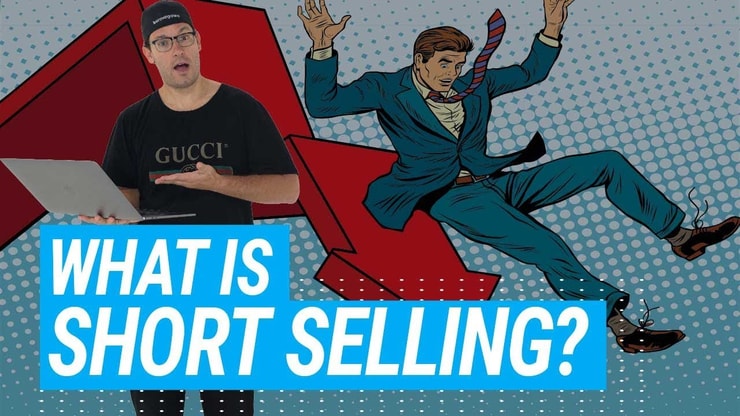



Leave a reply